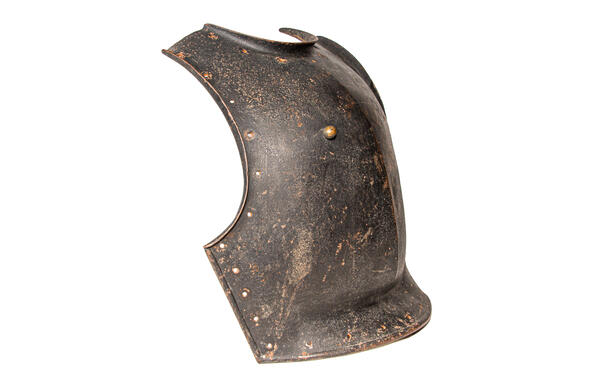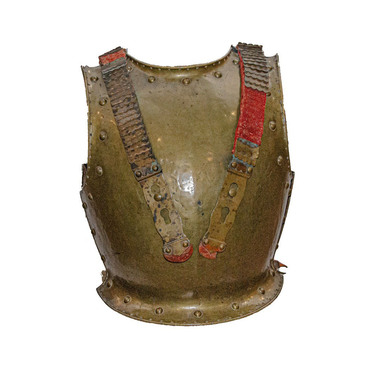Cuirassiers — the heavy cavalry that appeared in the 16th century in many European countries. They were supposed to compensate for the small number of knight cavalry. Cuirassiers wore relatively inexpensive armor, in design resembling the armor of German mercenary infantrymen of the Renaissance, which were called ‘landsknechts.’
Cuirasses are an element of body protective equipment. Traditionally, they consisted of two plates that rendered the shape of a human chest and back. The earliest armor was made of felt, and then it was covered with strong leather or metal sheets, most often copper. They were replaced by all-metal cuirasses later. They could be both an independent armor, and an equipage part.
Cuirasses are an element of body protective equipment. Traditionally, they consisted of two plates that rendered the shape of a human chest and back. The earliest armor was made of felt, and then it was covered with strong leather or metal sheets, most often copper. They were replaced by all-metal cuirasses later. They could be both an independent armor, and an equipage part.
The French cuirass from the museum’s exposition is a model of 1810. A technique resembling hot stamping was used to give it a certain shape: a sheet of iron was cut, heated it red-hot, then put into a cast-iron matrix mold and hammered it out with hand hammers.
If the matrix surface was smooth enough, the cuirass came out of it in a finished state, with little or no need to straighten it by hand. To make the metal of the combat cuirass stronger, it was specially tempered by placing the red-hot parts in a mold with cold water. Then they drilled holes in the armor for the fittings, attached a lining to it, an edging of a cord and buttons for shoulder and waist belts. After that, it was painted with black paint.
Sometimes, for additional protection against corrosion, cuirasses were made in two layers: the inner layer was forged from thin steel, and the outer layer was made of brass. The protective properties of all-steel and two-layer cuirasses were the same, but the durability of two-layer cuirasses was higher.
Polished iron cuirasses were produced rarely, mainly for the honor guard ceremonial armor. The upper hardened metal layer was removed during the polishing and its thickness was reduced.
Many types of battle armor in Europe disappeared by the end of the 17th century. Unlike them, the combat cavalry wore cuirasses until the middle of the 19th century. The armor practically did not protect against new smokeless powder rifles, but French cavalrymen continued to wear them in the field even in 1914.
If the matrix surface was smooth enough, the cuirass came out of it in a finished state, with little or no need to straighten it by hand. To make the metal of the combat cuirass stronger, it was specially tempered by placing the red-hot parts in a mold with cold water. Then they drilled holes in the armor for the fittings, attached a lining to it, an edging of a cord and buttons for shoulder and waist belts. After that, it was painted with black paint.
Sometimes, for additional protection against corrosion, cuirasses were made in two layers: the inner layer was forged from thin steel, and the outer layer was made of brass. The protective properties of all-steel and two-layer cuirasses were the same, but the durability of two-layer cuirasses was higher.
Polished iron cuirasses were produced rarely, mainly for the honor guard ceremonial armor. The upper hardened metal layer was removed during the polishing and its thickness was reduced.
Many types of battle armor in Europe disappeared by the end of the 17th century. Unlike them, the combat cavalry wore cuirasses until the middle of the 19th century. The armor practically did not protect against new smokeless powder rifles, but French cavalrymen continued to wear them in the field even in 1914.



